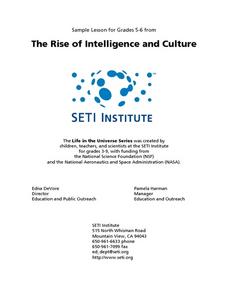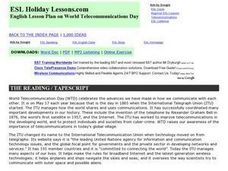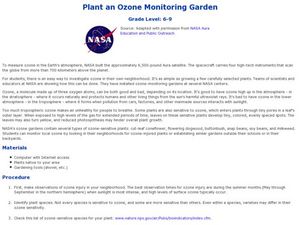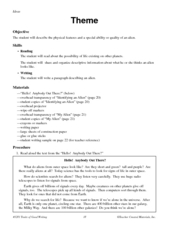Curated OER
Air and Water in the Environment
Students demonstrate an awareness of air as a substance that surrounds us and takes up space, and whose movement we feel as wind. They predict and describe how local weather conditions affect living things, including themselves.
Scholastic
Lesson One: The Earth, Background and Glossary
How much do you really know about our planet? Middle schoolers build up their prior knowledge about Earth, its placement in the solar system, its composition, and important geological vocabulary with an introductory earth science lesson.
Curated OER
Using Coordinate Geometry by Land, Sea and Outer Space.
Students complete a table of values and plot points, as well as construct a graph on a coordinate grid. They construct two graphs on the same coordinate system, and identify the point of intersection. Students represent and record...
Curated OER
E.T., Are You Out There?
Research the necessary components of a planet that supports life after reading the article "All of a Sudden, The Neighborhood Looks a Lot Friendlier" from The New York Times. After finding their information, middle and high schoolers...
Curated OER
Our Amazing Skeleton
Pupils study the skeleton, about the number of and types of bones in the body, and how outer space affects astronauts' bones. They discover how to take care of their bones here on Earth to prevent osteoporosis, or, weakening of the...
Curated OER
My Alien
Students listen to text read from "Hello! Anybody Out There?" and then brainstorm what aliens from outer space look like and do they exist at all.
They then will describe the physical features and a special ability or quality of an alien.
American Museum of Natural History
What's This? Life at the Limits
There are some amazing ways species evolve to survive. From large ears to sneezing salt, learners read about these interesting adaptations in an interactive lesson. Great to supplement an in-class lesson, it also works well as a remote...
Curated OER
Fourth Grade Science
In this science learning exercise, 4th graders complete multiple choice questions about electricity, the sun, sound, and more. Students complete 25 questions.
Curated OER
Extraterrestrial Communication: Can We Talk to Anybody Out There?
Students examine the possibilities of communication with other living organisms within our solar system through research and hands on activities, as well as observing and analyzing teacher demonstrations.
Teach Engineering
Are We Alone?
Find an answer to the age-old debate of whether life exists on Mars. Groups determine criteria to help look for signs of life on Mars. The activity has the class simulate testing Martian soil samples for signs of life before drawing...
University of Colorado
Can Photosynthesis Occur at Saturn?
In the 19th activity of 22, learners determine if distance from a light source affects photosynthesis. Participants capture oxygen in straws and find that the amount of water the gas displaces is proportional to the rate of photosynthesis.
Curated OER
Unity In Diversity
Students discuss the meaning of diversity in the world. They practice how to act around others and appreciate the different types of people that exist. The lesson includes a section of vocabulary and the reading of a story to illustrate...
Curated OER
Planet of Plenty
Students examine a small piece of land to determine the diversity of life on Earth. They role play as visitors from outer space seeing life on Earth for the first time. They measure and observe their plots while working in small groups....
Curated OER
Science Fiction Stories
Students write a story. In this genre lesson, students read a science fiction story and discuss its characteristics. Students brainstorm a list of things that if scientifically changed would alter the way we live our lives. Students...
Curated OER
Cnidarians Crossword Puzzle
For this crossword puzzle about Cnidarians worksheet, 6th graders write examples, words being defined, parts of the Cnidarians, and kinds of Cnidarians to complete the crossword puzzle review. Students write seventeen answers..
Curated OER
The Ancient World Explorer
Students investigate the ancient structures of Mesopotamia, Egypt, India, and China. In small groups, they conduct research, evaluate their findings within the group, create visual aides, and complete an Internet treasure hunt.
Curated OER
Viruses
In this virus activity, students answer questions about viruses, the parts of a virus and how viruses reproduce through the lytic and lysogenic cycle.
Curated OER
World Telecommunications Day
In this World Telecommunications Day worksheet, students complete activities such as complete activities such as reading a passage, phrase matching, fill in the blanks, correct words, multiple choice, spelling sequencing, scrambled...
Curated OER
World History Worksheet # 7 Questions
What do we know about the ancient Mayan civilization? In this world history instructional activity, middle schoolers utilize a word bank of 10 terms or phrases pertaining to the Mayan and Olmec to answer 10 fill-in-the-blank questions...
Curated OER
Biospheres
Second graders create models, practice inquiry skills, work with fellow students in teams, and reinforce concepts discussed in class all by using the theme of BIOSPHERES.
Curated OER
Plant an Ozone Monitoring Garden
Students create a garden. In this ozone lesson, students discuss ozone injury, identify plants sensitive to ozone, and then plant their own ozone garden.
Curated OER
Theme
Students examine a reading selection. In this descriptive writing lesson, students read an excerpt from "Hello! Anybody Out There?". Students discuss the idea of aliens living on other planets, describe what they think an alien looks...
Curated OER
Outerspace: Frontier for Personal Health and Hygiene
Students view photos of astronauts sleeping, eating, bathing, and using the toilet, and discuss hygiene problems in a zero-gravity environment. They contrast hygiene habits in space to those on Earth, and create storybooks illustrating...
Curated OER
How Does the Moon Affect Tidal Range?
Eighth graders study the phases of the moon. In this tides lesson students use the Internet to retrieve information.

























